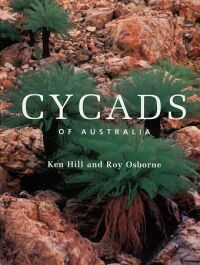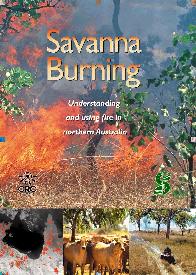|
[Front Page] [Features] [Departments] [Society Home] [Subscribe]

A Good Read
.....what's worth a look?
Reviews in this issue cover Cycads of Australia by Ken Hill and Roy Osborne, Field Guide to the Eucalypts, Volume 2 by M Brooker and D Kleinig and Savanna Burning by the Cooperative Research Centre for Tropical Savannas. |
 |

 
Cycads of Australia
Ken Hill and Roy Osborne
Update: May 2008 - We have been advised that this book is now out of print and even secondhand copies are hard to come by. At this time there are no plans for a reprinting or for a new edition.
Published by Kangaroo Press, Sydney, 2001
Hardback, 116 pages, colour illustrations
AUD$65.00
Reviewed by Kerry Rathie
For the short version, this book is excellent, and the first to cover this subject since 30 or so new species (of the 69 described here) were named in recent years. It is written by two experienced botanists and cycad enthusiasts who have seen virtually all the species in the wild, and all the photos were taken in the field, either by them or by members of ASGAP or PACSOA (Palm and Cycad Societies of Australia).
 
Ken Hill is a senior botanist at the Royal Botanic Gardens, Sydney, and has over the last 15 years or so revised the genus Cycas in Australia, the Pacific Islands and Asia. Roy Osborne studied cycads at the University of Natal for 20 years or so, then migrated to Australia about a decade ago, when he became commercially and scientifically involved in Australian cycads.
The book is similar to "The Grevillea Book" in having a colour shot of each species (and subspecies where relevant) in habitat, plus close-ups of cones, seeds and fronds in many cases.
It commences with 17 introductory pages of which 2 deal with cycad relationships world-wide, 2 with cycad anatomy and morphology, 3 with reproduction and seed dispersal, 3 with hybrids, 2 with aboriginal and Islander usage and cycad toxicity, 2 with conservation and 3 with cultivation. All of these are comprehensive, clear, and
marvels of compression.
Then there are 95 pages on the species, 1 page of books for further reading, 1 page on cycad-oriented websites, 1 on cycad-oriented societies and a 1-page index to species. There is no glossary as such, but the terms used, many more or less specific to cycads, are defined fully in the introductory pages.
The 69 species covered are arranged in families (Cycadaceae, Stangeriaceae, Zamiaceae), and within families arranged in groups of related species, and not alphabetically (a sure sign of a professional botanist!). Each species or subspecies has a location map, notes on distribution, habitat descriptions usually including soil, topography and climate details, conservation status (rarity etc.), a list of the main distinguishing features, and notes on any other unusual features.
The book is almost error-free (a typo at p. 63 needs 'Bowenia' deleted from the heading), up to date, and a great improvement on any other general book dealing with Australian cycads.
While being printed, a couple more rather insignificant-looking Macrozamia species have been described and named, and I expect a few more yet to come. Also, M.machinii, which is recognised as a separate species by the Brisbane Herbarium but not by the Sydney one, has been omitted, but a note on it is on p. 103. I supplied some of the slides for the book, and so know that more photos had been planned, and many included are much reduced in size, due to financial constraints. What remains is still excellent.
An entire book could be written on cultivation of cycads, so that section is necessarily less than complete. However, the habitat notes give a useful guide in most cases. The lists on p. 16 of cycads for various garden applications are correct as far as they go, but many other species could be listed in most categories. In particular, the list of cold-hardy cycads could be greatly extended, by Macrozamia moorei, M.feamsidei, M.lucida, M.miquelii and many more.
Reprinted from the Bulletin, newsletter of the Society for Growing Australian Plants (Queensland), June 2002.

 
Field Guide to the Eucalypts, Volume 2: South-western and Southern Australia
M.I.H. Brooker and D.A. Kleinig
Published by Bloomings Books, 2002
Hardback, 436 pages, colour illustrations
AUD$130.00
Reviewed by Jim Barrow
It probably suffices to say that this is a second edition of this book. In other words, it was so popular and useful that the original print-run quickly sold out. Demand remains high!
This volume aims to describe all the eucalypts in most of South Australia, in Western Australia below the latitude that bounds the north of South Australia, and in western New South Wales. (Volume 1 describes the rest of New South Wales, all of Victoria, and the southern part of South Australia; volume 3 describes the north).
The book starts with background information on the Eucalyptus genus which includes material needed to understand some of the later presentation. Then follows an extensive set of keys and then a detailed description of each species. Each description is allocated a whole page - pages are large, a bit shorter than A4. You get a detailed description, a small map of the distribution plus 4 or 5 pictures showing the important features of each species. The pictures usually include shots of the form of the tree, of the bark, and of the fruits and the buds. The plants are arranged in groups as classified by Brooker. The detailed classification of the various components of the Eucalyptus group is the subject of controversy, which needn't concern us here. (You will be either pleased or annoyed to find that Corymbia is given here as a sub genus.) Suffice it to say that arranging the plants with similar species on adjacent pages is very convenient. One can see just how similar species do differ. I wish the Grevillea Books had followed the same design.
However, I also rather wish we had been given some sort of a map. Just how does one recognise a Corymbia - whether as a sub genus or as a separate genus? And how does one get all the sub-genera, series and sections straight in one's mind? It is rather hard to assimilate when the descriptions are scattered through the book.
This is specified as the second edition. How does it differ from the first edition? Most obviously in the quality of the paper - much better in this one. But in content, one has to look closely to find the changes. Certainly most of the species previously designated as "species A" etc. now have specific names, but some four remain in alphabet designation. Some of the boundaries of the sub-groups have been moved. And there are some new names. I was disappointed to see that tallerack, which was previously E.tetragona, is given as E.pleurocarpa - disappointed because the name was easy to associate with the four angles of the stem. Also disappointed to find that in order to avoid remaking its page the reason for the change is given as a footnote in the introduction to its sub genus - five pages earlier and therefore hard to find. (The specimen on which the name tetragona was based is an intermediate form between the western tallerack and the eastern one. The name subsequently given to the western form - and rejected - is therefore restored).
The book should be owned by everyone with more than a passing interest in native plants - and what plants could be more Australian than the eucalypts? But if you already have the first edition, and it has not yet fallen to pieces from over-use, then I think you would only buy this one if you are really a eucalypt buff.
The book is published by Bloomings Books and is available from the Wildflower Society of Western Australia (Inc.) which assisted in its publication.

 
Savanna Burning
Published by Cooperative Research Centre for Tropical Savannas, 2002.
140 pages, colour illustrations,
AUD$30.00
The following information has been supplied by the publisher
This book describes how fire affects all aspects of the savanna landscape; it also provides some guidelines on how fire can be used to achieve multiple aims. It is designed as a concise, readable account of our current knowledge, and also as a general reference relating to fire management in the savannas of northern Australia.
To help you see which parts of the book might be most useful, the chapters are outlined below.
 
Chapter 1. Introduction
The Introduction describes the fire management issues that need to be addressed in northern Australia and introduces the people will need to be involved in solutions to these issues.
Chapter 2. Savanna landscapes
Savanna Landscapes describes the physical environment of the tropical savannas and shows how the different landscapes within the savannas have been shaped by climate, geology and soils. Despite this variation, all savanna landscapes share similar fire issues. Indeed these landscapes have been shaped by fire and long-term patterns of land use. Present day land use and fire patterns are in turn shaped by the landscapes and climate of the north.
Chapter 3. Savanna fire regimes
Having been given the physical setting, this chapter goes on to describe the different types of fire in the tropical savannas in more detail and introduces the concept of fire 'regimes'. It describes the broad characteristics of tropical savanna fire regimes and shows how they are affected by weather and vegetation - or 'fuel'. This chapter shows how different fire regimes are used by different land users for various tasks in the landscape. It briefly describes the current problems with the present fire regimes and how they affect conservation, production and culture.
Chapter 4. Effects of fire in the landscape
This chapter details the effects of the current fire regimes on the landscape - how the current fire patterns are impacting on activities and values ranging from pastoralism to traditional practices to biodiversity. How are fire regimes affecting the ratio of trees to shrubs; of annual to perennial grasses? How are they affecting fire-sensitive plant species in sandstone country? What impact do fire patterns have on various native animals? How do they change air quality and water quality?
Chapter 5. Using fire in savanna management
Using fire shows how better fire management can overcome many of the problems described in Chapter 4. Fire management techniques are described for Aboriginal land, pastoral land and for managing biodiversity. It is explained, for example, which burning regimes can be used to enhance pasture vigour; to control weeds; to provide habitat for native animals and to protect against wildfires.
Chapter 6. Burning operations
Once you know what fire regimes are needed, 'operations' describes how to put that knowledge into practice. It describes when and where to light fires for particular tasks; what ignition techniques can be used and how to plan for burning. The construction of firebreaks is detailed. The legislation that governs the lighting of fire in WA, NT and Queensland is also referenced.
Chapter 7. Monitoring fire regimes
How do you know that fire management is working? You need to be able to monitor the effects of fire on the landscape and then, if necessary, use these results to change existing fire management. Monitoring techniques involving plots, aerial photography and satellite remote sensing are described. The complex language and high technology of satellite monitoring is explained.
Chapter 8. Global trends and fire management
Finally, we look to the future. This chapter examines how fire management will be affected by various global and local trends including greenhouse issues and carbon trading, globalisation of markets, new laws covering biodiversity and air quality, and the impact of native title legislation.
An order form and more information about the book is available on the Tropical Savannas CRC website (Look at the "Publications section").

[Front Page] [Features] [Departments] [Society Home] [Subscribe]
Australian Plants online - June 2002
Association of Societies for Growing Australian Plants
|